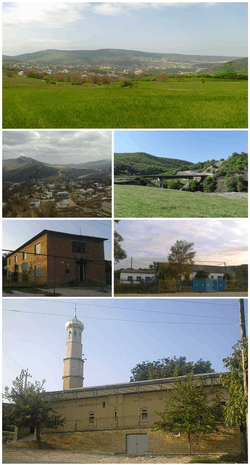Kalininaul, Kazbekovsky District, Republic of Dagestan
| Kalininaul (English) Калининаул (Russian) Юрт-Аух (Chechen) | |
|---|---|
|
- Rural locality[1] - Selo[1] | |
 Views of Kalininaul | |
.svg.png) Location of the Republic of Dagestan in Russia | |
 Kalininaul | |
|
| |
| Administrative status (as of 2010) | |
| Country | Russia |
| Federal subject | Republic of Dagestan[1] |
| Administrative district | Kazbekovsky District[1] |
| Statistics | |
| Population (2010 Census) | 4,531 inhabitants[1] |
| Time zone | MSK (UTC+03:00)[2] |
| Kalininaul on Wikimedia Commons | |
Kalininaul (Russian: Калининаул; Chechen: Юрт-Аух) is a rural locality (a selo) in Kazbekovsky District of the Republic of Dagestan, Russia, located on the right bank of the Aktas River, at the confluence with the Sala-su River, opposite the selo of Leninaul, 18 kilometers (11 mi) south of Khasavyurt on the border with the Chechen Republic. Population: 4,531 (2010 Census);[1] 4,439 (2002 Census);[3] predominantly Chechen.
History
It was the first settlement of Chechen-Akkints in the Kumyk Plain. It was previously known as Shircha-Akka, Shircha-Evla, Yurt-Evla, and Yurt-Aukh.
Yurt-Aukh, as it was then called, was until 1944 a part of the Aukhovsky District. In 1944, during the deportation of Chechens to Central Asia, the locals were deported and Avars from the neighboring selo of Almak settled in their place.
In 1956, the Chechens were allowed to return to the Caucasus, but the local authorities prohibited their return directly to their ancestral villages in former Aukhovsky District. Only several years later the Chechens were able to start buying back their houses from the Avars.
On August 27, 2007, a clash between over one hundred Chechens and Avars took place in Kalininaul, resulting in eight people injured.
Infrastructure
An elementary and a secondary school operate in Kalininaul. There is also a House of Culture, a post office, a kindergarten, and four mosques (two Chechen and two Avar).
Teips
The village is inhabited by the following Akkint teips (clans):
- Akkoy
- Pharchhoy
- Bittroy
- Chenti
- Chontoy
- Shinroy
- Nokkhoy
- Vyappy
References
- 1 2 3 4 5 6 Russian Federal State Statistics Service (2011). "Всероссийская перепись населения 2010 года. Том 1" [2010 All-Russian Population Census, vol. 1]. Всероссийская перепись населения 2010 года (2010 All-Russia Population Census) (in Russian). Federal State Statistics Service. Retrieved June 29, 2012.
- ↑ Правительство Российской Федерации. Федеральный закон №107-ФЗ от 3 июня 2011 г. «Об исчислении времени», в ред. Федерального закона №271-ФЗ от 03 июля 2016 г. «О внесении изменений в Федеральный закон "Об исчислении времени"». Вступил в силу по истечении шестидесяти дней после дня официального опубликования (6 августа 2011 г.). Опубликован: "Российская газета", №120, 6 июня 2011 г. (Government of the Russian Federation. Federal Law #107-FZ of June 31, 2011 On Calculating Time, as amended by the Federal Law #271-FZ of July 03, 2016 On Amending Federal Law "On Calculating Time". Effective as of after sixty days following the day of the official publication.).
- ↑ Russian Federal State Statistics Service (May 21, 2004). "Численность населения России, субъектов Российской Федерации в составе федеральных округов, районов, городских поселений, сельских населённых пунктов – районных центров и сельских населённых пунктов с населением 3 тысячи и более человек" [Population of Russia, Its Federal Districts, Federal Subjects, Districts, Urban Localities, Rural Localities—Administrative Centers, and Rural Localities with Population of Over 3,000] (XLS). Всероссийская перепись населения 2002 года [All-Russia Population Census of 2002] (in Russian). Retrieved August 9, 2014.